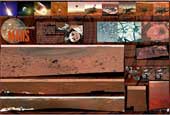
 |
|
|
This superb book, subtitled ‘Perilous Adventures in the Competition to Measure the Earth’, is a fascinating account of the navigational and astronomical work instructed by the French Government to the Paris Academy of Sciences from the seventeenth to nineteenth centuries. It was a time of revolution and enlightenment. It was a time of national identity and for Paris to be seen as taking an assured lead in positional navigation with a vanguard capable of delivering. Murdin brings together for the first time the full story of the Paris Meridian, which has seemingly maintained a lovely cultural title of La Méridienne Verte (The Green Meridian); so called for the encouragement of land owners to plant trees along the meridian! For France the definition of ‘Meridian’ is extended from the north-side polar line to include real-time. Thereby, through new geographic triangulation and culmination studies of the night sky, borders and boundaries could be significantly redrawn. At the height of political and social change in Europe, this was vital. Murdin establishes the basis for the ongoing work quickly, which is a distinct quality of this book. The evidence here perhaps sympathetically portrays the scientists’ hopes to be removed from national and international disputes, but it is clear that with travels to Spain, Northern Scandinavia and even South America, their hopes were often dashed. The emerging heroes for me in this story are Pierre-François André Mechain (1744–1804), Jean-Baptiste Biot (1774–1862) and Dominique François Jean Arago (1786–1853). Mechain, who was grounded in astronomy and mathematics through the lectures of Laplace, had worked as part of an Anglo–French team on the longitude variations between Greenwich and Paris in 1787. By 1792, he was leaving revolutionary Paris to undertake the abstraction work from the meridian that took him south-west into Spain, toward Barcelona and eventually Castillón. The death of Mechain left Biot as the leading mathematician at the Paris Observatory, who proposed that Arago accompany him to continue the work of Mechain. Arago’s story in itself is a remarkable account by Murdin and the real highlight. This is an outstanding book and a real benchmark in the wealth of astronomical historical studies of the period. Ian Welland
|
|
|
|
2009 Yearbook This 132-page special edition features the ultimate observing guide for 2009, a review of all the biggest news stories of 2008, in depth articles covering all aspects of astronomy and space missions for 2009, previews of International Year of Astronomy events and much, much more. This 132-page special edition features the ultimate observing guide for 2009, a review of all the biggest news stories of 2008, in depth articles covering all aspects of astronomy and space missions for 2009, previews of International Year of Astronomy events and much, much more.Infinity Rising  This special publication features the photography of British astro-imager Nik Szymanek and covers a range of photographic methods from basic to advanced. Beautiful pictures of the night sky can be obtained with a simple camera and tripod before tackling more difficult projects, such as guided astrophotography through the telescope and CCD imaging. This special publication features the photography of British astro-imager Nik Szymanek and covers a range of photographic methods from basic to advanced. Beautiful pictures of the night sky can be obtained with a simple camera and tripod before tackling more difficult projects, such as guided astrophotography through the telescope and CCD imaging.Exploring Mars  Astronomy Now is pleased to announce the publication of Exploring Mars. The very best images of Mars taken by orbiting spacecraft and NASA's Spirit and Opportunity rovers fill up the 98 glossy pages of this special edition! Astronomy Now is pleased to announce the publication of Exploring Mars. The very best images of Mars taken by orbiting spacecraft and NASA's Spirit and Opportunity rovers fill up the 98 glossy pages of this special edition!Mars rover poster  This new poster features some of the best pictures from NASA's amazing Mars Exploration Rovers Spirit and Opportunity. This new poster features some of the best pictures from NASA's amazing Mars Exploration Rovers Spirit and Opportunity. |
||||||||||||||||||||||||